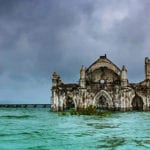 Weird Stuff
Weird Stuff  Weird Stuff
Weird Stuff  Mysteries
Mysteries 10 Tragic Disappearances and Deaths in Joshua Tree National Park
 History
History 10 Ways Childhood Really Sucked in the Old West
 Music
Music 10 Name Origins of Famous Bands from the 1990s
 Religion
Religion 10 Biggest Turnarounds by the Catholic Church
 Weird Stuff
Weird Stuff 10 Unbelievable Times Laws Had Unintended Consequences
 Humans
Humans Ten Historic Women Who Deserve Way More Credit Than They Got
 Movies and TV
Movies and TV 10 Films That Spawned Major Lawsuits
 History
History Ten Times Towns Were Wiped Off the Face of the Earth
 Creepy
Creepy 10 of the Most Disturbingly Haunted Public Houses in the UK
 Weird Stuff
Weird Stuff 10 Niche Subcultures That Are More Popular Than You Might Think
 Mysteries
Mysteries 10 Tragic Disappearances and Deaths in Joshua Tree National Park
 History
History 10 Ways Childhood Really Sucked in the Old West
Who's Behind Listverse?

Jamie Frater
Head Editor
Jamie founded Listverse due to an insatiable desire to share fascinating, obscure, and bizarre facts. He has been a guest speaker on numerous national radio and television stations and is a five time published author.
More About Us Music
Music 10 Name Origins of Famous Bands from the 1990s
 Religion
Religion 10 Biggest Turnarounds by the Catholic Church
 Weird Stuff
Weird Stuff 10 Unbelievable Times Laws Had Unintended Consequences
 Humans
Humans Ten Historic Women Who Deserve Way More Credit Than They Got
 Movies and TV
Movies and TV 10 Films That Spawned Major Lawsuits
 History
History Ten Times Towns Were Wiped Off the Face of the Earth
 Creepy
Creepy 10 of the Most Disturbingly Haunted Public Houses in the UK
10 Dark Tourist Destinations in the UK
Darkness falls early in Britain. Its ancient history is rich with murder, disease, and natural disasters, which makes it the perfect destination for dark and macabre tours—if you dare.
Stroll through the streets of London where serial killers have stalked their prey and thousands were killed by plague, fire, and wartime bombs. Travel to the countryside where Norman churches reveal gruesome secrets and medieval towns hide shameful pasts. While many seek only to walk in the steps of Jack the Ripper or visit the Tower of London to check of their “dark tourism” box, many other dark places can be experienced.
Let’s embrace the misery along with the rain and take a trip around some of the creepiest places in Britain.
Related: Top 10 Famous Haunted Landmarks You Didn’t Know Were Haunted
10 Lord Lucan’s House
The first stop on our list is 46 Lower Belgrave Street, a six-story house in the exclusive London borough of Westminster. In 1974, it was home to Richard John Bingham, the 7th Earl of Lucan, and his wife, Veronica.
The couple separated and became locked in a bitter custody battle, and Lady Lucan remained on the property with their children. On November 7, their nanny Sandra Rivett entered the dark basement and was bludgeoned to death with a lead pipe. When Lady Lucan went to investigate, she was also attacked in the dark. However, she was able to escape to the nearby Plumbers Arms pub, soaked in blood and badly injured.
Rivett’s body was found in the basement, stuffed into a mail sack with a bloody footprint next to it. Lucan vanished into the night; the only clue was a length of bandaged lead pipe found inside his car, which had been dumped miles away. An inquest ruled that Lucan was most likely the murderer—having mistaken Rivett for his wife in the gloomy basement.
Lucan’s body has never been found, but over the years, sightings of him have been reported from India and Africa. Rivett’s son believes he is an elderly Buddhist man living in Australia. Lord Lucan was officially declared dead in 1999.[1]
9 Beachy Head
Beachy Head is the highest chalk sea cliff in Britain, with stunning views across the south coast. Tourists flock to the cliffs for walks and picnics, but the area has gained global notoriety for darker reasons. The cliffs stand 162 meters (530 feet) above sea level, making it a very effective spot for suicide.
It is so popular that 500 people have died here since 1965. Not all these deaths have been by suicide; some have perished in cars plunging over the edge, others have been murdered. Many have slipped and fallen over the crumbling cliff edge while posing for photos.
In June 2018, three bodies—all unrelated—were found below the cliffs in one day. People from around the world have traveled here to end their life, with tourists—either unwittingly or intentional—visiting the scene of these self-inflicted or nefarious deaths. Volunteers regularly patrol the area and rescue around 500 desperate people a year from the cliffs.[2]
8 Ruth Ellis
Ruth Ellis was the last woman to be hanged in Britain, aged 28. On Easter Sunday 1955, Ruth followed former lover David Blakely to the Magdala pub in Hampstead. As he left the building, Ruth stepped out from a doorway, took a gun from her purse, and fired two shots into Blakely. She walked over to his prone body and fired two additional shots. Then she calmly asked bystanders to call the police.
Police investigating the cold-blooded murder revealed a relationship of violence and abuse. However, the law at the time did not allow for the abuse—including a few trips to the hospital and a miscarriage likely from a punch to the stomach—to factor in her trial and reduce the charge from murder to manslaughter. She was convicted and hanged. Public outcry and protest eventually led to abolishing the death penalty in Britain.
As the aftermath of the crime still lingers, so does the location. The Magdala is a favorite on the dark tourism trail, mainly due to the bullet holes still visible in the pub walls. Rumor has it, though, that they were added with a drill in the 1990s as a way to increase visitor numbers.[3]
7 St. Leonard’s Church, Hythe
Hythe is a sleepy town on the Kent Coast and home to St. Leonard’s Church, built around 1090. Deep in its crypt, you will find over 1000 human skulls and a stack of bones. Historians estimate that these are the remains of 4000 people—but no one knows why they are there.
The crypt, known as “The Bonehouse” or “Ossuary,” is rumored to house victims of the Black Death, murdered Vikings, or shipwrecked pirates. As the bones are mainly female, they are believed to be from locals whose bodies were exhumed and re-housed in the church during building works carried out in the 13th century.
A polite note rests next to the bones asking visitors not to disturb the 700-year-old residents. In 2018, thieves smashed a lock and stole 21 skulls from the collection. They have never been recovered.[4]
6 Canvey Island
Canvey Island in Essex is made up of land reclaimed from the Thames Estuary and lies just above sea level. On January 31, 1953, a massive storm hit the North Sea, causing a tidal surge that burst through the sea wall surrounding Canvey.
Flood water poured into the island, trapping residents in their homes. Many climbed onto the roofs for safety, where they died due to shock and hypothermia. Others died from heart attacks or drowned in the rising waters. Fifty-nine people lost their lives, and 13,000 were evacuated. The sea wall, previously made from little more than earth and grass, has been replaced by solid flood barriers.
Today, Canvey Island is a haven for birds and rare insects alongside a memorial to the flood victims.[5]
5 Lancaster Castle and the Pendle Witches
Britain in the early 1700s was a place of fear and suspicion as King James began a campaign of terror to rid the country of witches. The remote village of Pendle in Lancashire became a hotspot when a local woman, Alizon Device, was accused of witchcraft. She was begging at the roadside when a traveling salesman refused to give her some pins, and as she cursed him, he fell to the ground and became paralyzed.
Villagers accused Alizon of being a witch and arrested her along with several members of prominent local families. They were held in the dungeons of Lancaster Castle on various charges, including old unsolved murders.
The trial of the Pendle Witches took place in August 1612. The star witness was 9-year-old Jennet Device, who gave evidence against her own mother, Elizabeth. Ten people were sentenced to death, dragged past the jeering crowds, and hanged on gallows high up on the windswept moors surrounding the castle.
Today you can visit the eerily atmospheric Lancaster Castle or venture to nearby St. Mary’s Church and see the grave of Alice Nutter, one of the accused. The church has an “evil eye” in its turret to ward off malevolent spirits.[6]
4 The Blind Beggar Pub
The Kray Twins—Ronnie and Reggie—were infamous criminals who controlled London’s underworld in the 1960s. Together with their gang “The Firm,” they committed armed robberies and ran protection rackets, controlling local businesses through fear.
George Cornell was a member of a rival gang, The Richardsons, who had been involved in a shoot-out with a known Kray associate. On March 9, 1966, Cornell arrived at The Blind Beggar pub in Whitechapel, East London—seen as being Kray “territory”—and settled onto a bar stool. Word quickly got to Ronnie Kray, who walked into the pub, fired a single shot into Cornell’s forehead with a 9mm Luger, then strolled out toward a waiting car.
It took three years for Kray to be sentenced to life for the murder as no witnesses came forward. Today, The Blind Beggar is a thriving East End pub, and a pool table now stands in the spot where Cornell was gunned down.[7]
3 Hampton Court Palace
The Tower of London is the capital’s most ghoulish attraction—many people were murdered within its walls. But there is another London palace with a strange and murky past.
Hampton Court Palace is located just outside London and was home to Henry VIII and his assortment of six wives. Third wife Jane Seymour died here in 1573, days after giving birth. Her shadowy figure has been seen lingering on the Silverstick Stairs, leading to the room where she died.
Fifth wife, teenager Catherine Howard was arrested for adultery and dragged screaming through the Palace grounds to meet her executioner at the Tower of London.
After dark, you may hear the faint sound of a spinning wheel from behind a wall, said to belong to the “Grey Lady,” a loyal servant to four Tudor monarchs.[8]
2 10 Rillington Place
An ordinary street in Notting Hill, London, has had several name changes. Now Bartle Road, formerly Ruston Close and most famously, Rillington Place. John Christie lived at number 10, and it was here that he gassed and strangled eight women, including his wife. Their bodies were hidden behind the kitchen walls, under floorboards, and in the garden. Timothy Evans, who lived in rooms upstairs, was wrongly found guilty and hanged for the murders of his wife and daughter—after Christie had killed them.
The other bodies were found behind a wall when Christie moved out, and the new tenants attempted to put up shelves.
Christie was hanged in 1953, and the address changed names before finally being demolished in 1978. During Christie’s reign of terror, the street was a slum, but it is now one of the most desirable areas of London. Bartle Close and Andrews Square were later built on top of the site to cover the burial ground.[9]
1 23 Cranley Gardens
Once dubbed the “House of Horrors,” 23 Cranley Gardens sits in a leafy North London street. Serial killer Denis Nilsen lived here and murdered at least three young men in the tiny attic flat.
Unlike at his first property, where he had killed nine men, Nilsen did not have access to an outside space in order to burn the bodies. Instead, he began a complicated process of boiling body parts and flushing them down the toilet. Eventually, they blocked the drains. Police were called when plumbers found human flesh, and Nilsen calmly confessed to 12 murders. Denis Nilsen was sentenced to life imprisonment and died in 2018.
The property has changed hands several times, with potential buyers being urged to research its history before viewing.[10]








